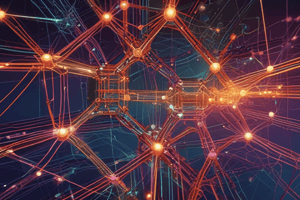Podcast
Questions and Answers
What is a data communication network?
What is a data communication network?
- A collection of nodes and connections facilitating data exchange (correct)
- A storage device for backing up data
- A program for analyzing network traffic
- A single computer used for data processing
Which of these is an example of a node in a data communication network?
Which of these is an example of a node in a data communication network?
- A computer (correct)
- A network topology
- A network protocol
- A data packet
What does LAN stand for?
What does LAN stand for?
- Large Area Network
- Longitudinal Area Network
- Local Area Network (correct)
- Linked Area Network
Which type of network spans a large geographical area?
Which type of network spans a large geographical area?
Which network topology connects devices in a circular path?
Which network topology connects devices in a circular path?
In a star topology, all devices are connected to a:
In a star topology, all devices are connected to a:
What is the purpose of TCP/IP?
What is the purpose of TCP/IP?
Which protocol is used for transferring data on the web?
Which protocol is used for transferring data on the web?
Which network device forwards data packets between networks?
Which network device forwards data packets between networks?
What is the function of a firewall?
What is the function of a firewall?
Which data transmission mode allows data transfer in one direction only?
Which data transmission mode allows data transfer in one direction only?
Which switching technique divides data into packets?
Which switching technique divides data into packets?
What are IP addresses used for?
What are IP addresses used for?
Which wireless technology is based on the IEEE 802.11 standards?
Which wireless technology is based on the IEEE 802.11 standards?
What is bandwidth a measure of?
What is bandwidth a measure of?
Which of the following is a layer in the TCP/IP model?
Which of the following is a layer in the TCP/IP model?
Which of these provides faster speeds and lower latency compared to 4G?
Which of these provides faster speeds and lower latency compared to 4G?
Flashcards
Data Communication Network
Data Communication Network
A collection of interconnected nodes facilitating data exchange.
Local Area Network (LAN)
Local Area Network (LAN)
Connects devices in a limited area like an office or home.
Wide Area Network (WAN)
Wide Area Network (WAN)
Spans larger geographical areas, connecting multiple LANs.
Metropolitan Area Network (MAN)
Metropolitan Area Network (MAN)
Signup and view all the flashcards
Personal Area Network (PAN)
Personal Area Network (PAN)
Signup and view all the flashcards
Bus Topology
Bus Topology
Signup and view all the flashcards
Star Topology
Star Topology
Signup and view all the flashcards
Ring Topology
Ring Topology
Signup and view all the flashcards
Mesh Topology
Mesh Topology
Signup and view all the flashcards
Tree Topology
Tree Topology
Signup and view all the flashcards
TCP/IP
TCP/IP
Signup and view all the flashcards
HTTP
HTTP
Signup and view all the flashcards
FTP
FTP
Signup and view all the flashcards
SMTP
SMTP
Signup and view all the flashcards
DNS
DNS
Signup and view all the flashcards
Routers
Routers
Signup and view all the flashcards
Switches
Switches
Signup and view all the flashcards
Hubs
Hubs
Signup and view all the flashcards
Firewalls
Firewalls
Signup and view all the flashcards
Simplex Transmission
Simplex Transmission
Signup and view all the flashcards
Study Notes
- A data communication network is a collection of nodes and connections that facilitate data exchange between different points.
- Nodes can include devices such as computers, servers, and networking hardware.
- Connections between nodes are established using communication channels like cables or wireless links.
Network Types
- Local Area Networks (LANs) connect devices within a limited area like an office or home.
- Wide Area Networks (WANs) span larger geographical areas, connecting multiple LANs and other networks.
- Metropolitan Area Networks (MANs) cover an area larger than a LAN but smaller than a WAN, like a city.
- Personal Area Networks (PANs) are small networks used by one person, such as a Bluetooth connection between a phone and headset.
Network Topologies
- Bus topology involves all devices connected to a central cable.
- Star topology features all devices connected to a central hub or switch.
- Ring topology connects devices in a circular path where data travels in one direction.
- Mesh topology provides multiple paths between devices for redundancy and fault tolerance.
- Tree topology combines characteristics of bus and star topologies, forming a hierarchical structure.
Network Protocols
- TCP/IP (Transmission Control Protocol/Internet Protocol) is a suite of protocols for communication over the Internet.
- HTTP (Hypertext Transfer Protocol) is used for transferring data on the web.
- FTP (File Transfer Protocol) is used for file transfer between a client and server.
- SMTP (Simple Mail Transfer Protocol) is used for sending email.
- DNS (Domain Name System) translates domain names to IP addresses.
Network Devices
- Routers forward data packets between networks.
- Switches connect devices within a network using MAC addresses.
- Hubs connect devices in a network by broadcasting data to all connected devices.
- Modems modulate and demodulate signals for transmission over telephone lines or other media.
- Firewalls protect a network from unauthorized access and malicious traffic.
Data Transmission Modes
- Simplex transmission allows data transfer in one direction only.
- Half-duplex transmission allows data transfer in both directions, but only one direction at a time.
- Full-duplex transmission allows data transfer in both directions simultaneously.
Multiplexing Techniques
- Frequency Division Multiplexing (FDM) divides the available bandwidth into multiple frequency bands, each used for a separate channel.
- Time Division Multiplexing (TDM) divides the available time into slots, each allocated to a different channel.
- Wavelength Division Multiplexing (WDM) transmits multiple data streams simultaneously over a single optical fiber using different wavelengths of light.
Switching Techniques
- Circuit switching establishes a dedicated path between sender and receiver for the duration of the communication.
- Packet switching divides data into packets, each transmitted independently and reassembled at the destination.
- Message switching sends entire messages as a single unit, with each switch storing the message until a path is available.
Network Addressing
- IP addresses are logical addresses used to identify devices on a network.
- IPv4 addresses are 32-bit addresses, while IPv6 addresses are 128-bit addresses.
- MAC addresses are physical addresses assigned to network interfaces.
Network Security
- Firewalls control network access and prevent unauthorized traffic.
- Intrusion detection systems (IDS) monitor network traffic for malicious activity.
- Virtual Private Networks (VPNs) create a secure connection over a public network.
- Encryption protects data confidentiality by encoding it so that only authorized parties can read it.
Wireless Communication
- Wi-Fi is a wireless networking technology based on the IEEE 802.11 standards.
- Bluetooth is a short-range wireless technology for connecting devices like headphones, keyboards, and mice.
- Cellular networks provide wireless communication over a wide area using cell towers.
Network Performance Metrics
- Bandwidth is the amount of data that can be transmitted over a network connection in a given amount of time.
- Latency is the delay between sending a data packet and receiving it.
- Throughput is the actual rate of data transfer over a network connection.
- Jitter is the variation in latency over time.
- Packet loss is the percentage of data packets that are lost during transmission.
Network Models
- The OSI (Open Systems Interconnection) model is a conceptual framework for understanding network communication.
- The TCP/IP model is a practical model used by the Internet, consisting of four layers: Application, Transport, Internet, and Link.
Network Management
- Network monitoring tools track network performance and identify potential problems.
- Configuration management involves maintaining and updating network device configurations.
- Network security management includes implementing and enforcing security policies.
- Network capacity planning involves forecasting future network needs and ensuring sufficient resources are available.
Cloud Networking
- Cloud networking involves using cloud-based resources to build and manage networks.
- Software-Defined Networking (SDN) allows network administrators to manage network resources programmatically.
- Network Functions Virtualization (NFV) virtualizes network functions, such as firewalls and load balancers, allowing them to be deployed on commodity hardware.
Emerging Trends
- 5G is the fifth generation of cellular technology, offering faster speeds and lower latency compared to 4G.
- Internet of Things (IoT) involves connecting everyday devices to the Internet, creating a network of interconnected devices.
- Edge computing involves processing data closer to the edge of the network, reducing latency and improving performance.
Error Detection and Correction
- Parity checks add an extra bit to a data string to ensure that the number of 1s is either even or odd, detecting single-bit errors.
- Cyclic Redundancy Check (CRC) is a more advanced error detection method that calculates a checksum based on the data.
- Hamming codes can detect and correct single-bit errors by adding redundant bits to the data.
Congestion Control
- Congestion occurs when the network is overloaded with traffic, leading to delays and packet loss.
- Congestion control mechanisms aim to prevent and alleviate congestion by adjusting the rate at which data is sent.
- TCP congestion control algorithms, such as TCP Tahoe, TCP Reno, and TCP Cubic, are used to manage congestion in TCP networks.
Quality of Service (QoS)
- QoS refers to the ability of a network to provide different levels of service to different types of traffic.
- QoS mechanisms, such as traffic shaping and prioritization, are used to ensure that critical applications receive the necessary bandwidth and latency.
Virtualization
- Network virtualization creates virtual versions of network resources, such as switches, routers, and firewalls.
- Virtual networks can be used to isolate traffic, improve security, and simplify network management.
Content Delivery Networks (CDNs)
- CDNs are distributed networks of servers that store and deliver content to users based on their geographic location.
- CDNs can improve website performance by reducing latency and increasing bandwidth.
Network Address Translation (NAT)
- NAT translates private IP addresses to public IP addresses, allowing multiple devices on a private network to share a single public IP address.
- NAT can also provide a layer of security by hiding the internal network structure from the outside world.
Studying That Suits You
Use AI to generate personalized quizzes and flashcards to suit your learning preferences.




